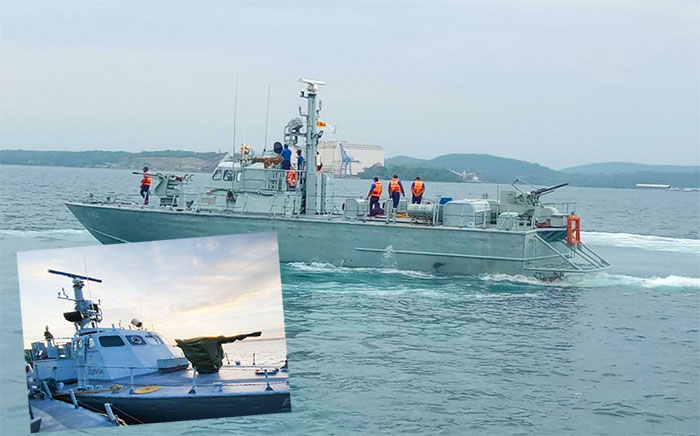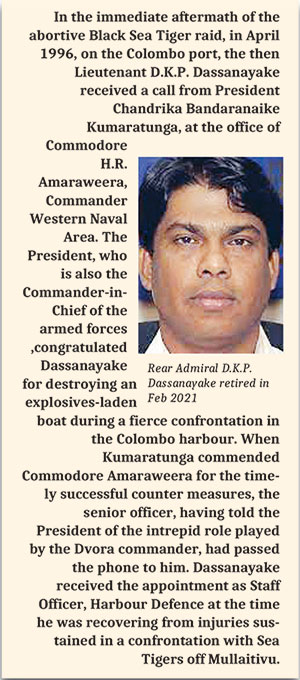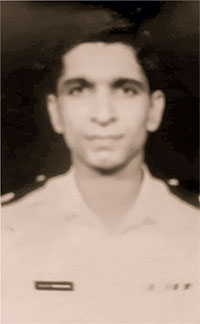SPECIAL REPORT : Part 439
By Shamindra Ferdinando
Having read the writer’s review of ex-Lankadeepa defence correspondent Ratnapala Gamage’s Ranabime Panhinda (Notes from the battlefront), retired Lieutenant L.S.A.N.T. Siriwardhana sought an explanation regarding the absence of at least a reference to the high profile raid on the Colombo harbour, in April 1996.
The Australia-Sri Lanka dual citizen pointed out that the unprecedented LTTE (Liberation Tigers of Tamil Eelam) foray into the heavily guarded Colombo port never received the attention it deserved.
“Ratnapala Gamage discussed the commando-style LTTE raid on the Bandaranaike International Airport, carried out in late July 2001 though he left out April 1996 raid on the Colombo port,” Siriwardhana said, asserting perhaps the media never had sufficient access to the required information.
Siriwardhana declared that he felt the need to discuss the Colombo port attack against the backdrop of Sri Lanka’s latest humiliating defeat at the Geneva-based United Nations Human Rights Council (UNHRC). In the absence of a comprehensive examination of the overall war, with the focus on major specific incidents and developments, successive governments failed to counter continuing propaganda against the country, and its valiant fighting men, by interested parties.
Siriwardhana said that even over 12 years after the successful conclusion of the war, the government hadn’t been able to properly record the conflict. Therefore, Sri Lanka’s failure to effectively counter propaganda and the resultant developments should be a matter of serious concern, Siriwardhana said.
LTTE issues statements from London
Following the raid on the Colombo port, on April 12, 1996, the LTTE issued two statements from its International Secretariat, situated at 211, Katherine Road, London E 6, IBU, UK. The LTTE credited the Black Sea Tigers with the attack. It also showed how the British continued to mollycoddle the terrorists, on its soil, even long after the Tigers assassinated former Indian Prime Minister Rajiv Gandhi, in May 1991, on all types of pretexts. The UK turned a blind eye to the assassination of President Ranasinghe Premadasa and several lawmakers. Having openly nurtured Tiger terrorists we wonder whether the UK has any right to accuse us of doing any wrong in single handedly crushing that organization, termed by none other than the US Federal Bureau of Investigation, as the most ruthless terrorist organization.
According to the LTTE statements, dated April 13 and 15, 1996, Black Sea Tigers succeeded in destroying three Fast Attack Craft (FACs) and three supply vessels, in the Colombo harbour. The writer covered the Black Sea Tiger incursion which, according to the Sri Lanka Ports Authority (SLPA), had been detected by two minor employees. The two employees, identified as boatmen, had made the chance detection, off the Jaya Container Terminal Stage One. Swift intervention, by the Navy, led to the destruction of an explosive-laden suicide craft, close on the heels of the killing of two underwater saboteurs (LTTE frogmen, identified themselves as ‘Aiya’ (April 15, 1996, The Island). But, later, the deaths of altogether at least four underwater saboteurs were reported.
The Black Sea Tigers raided the Colombo port one year after the LTTE’s extraordinary success in the East, as it launched Eelam War III. The LTTE resumed open warfare, without any warning, with the sinking of two Shanghai Class gunboats moored at the gunboat pier at the SLN dockyard, in the Trincomalee harbour. Underwater saboteurs blasted the vessels SLNS Ranasuru and SLNS Soorya, acquired in 1991 and 1971, respectively, just hours after the LTTE quit the Norwegians arranged negotiations. The LTTE credited two men, and an equal number of women of the Black Sea Tigers, for the attack. A week later, the LTTE brought down two Avro transport aircraft over the strategic Palaly airbase, on two consecutive days. The military lost over 100 officers and men. Shoulder-fired heat-seeking missiles, acquired from the Mujahedeen, in Afghanistan, delivered stunning blows. The suicide strikes, and the introduction of missiles, stunned the Chandrika Bandaranaike Kumaratunga government.
But, the raid on the Colombo port, a year later, involved both Black Sea Tigers and an explosive-laden boat.
It was meant to cripple the economy by discouraging foreign vessels, plying international shipping lanes, calling on Colombo. Had the LTTE succeeded, Sri Lanka would have suffered irreparable damage.
It would be pertinent to mention that the LTTE targeted the Colombo port, in the aftermath of the loss of the Jaffna peninsula. Operation ‘Riviresa,’ involving three Divisions, brought back Jaffna town, and its suburbs, under government control, in the first week of Dec. 1995. Having secured the Waligamam region, by Dec. 1995, the military consolidated about 50 percent of the Thennamarachchi and Vadamaratchcy sectors, in the peninsula, by April 1996. The then President CBK’s administration had the upper hand with the entire peninsula under its control. Having launched Eelam War III, the LTTE lost Jaffna peninsula, before the end of that year, and sought to deliver a knock-out blow. The LTTE picked Colombo port to stage a spectacular attack. In spite of 24-hour surveillance, after months of reconnaissance, undertaken by Tiger intelligence operatives, the LTTE mounted the operation on April 12, 1996, as the country was preparing to celebrate the Sinhala and Tamil New Year.
Successful counter-attack
Siriwardhana, who had been the Command Operations Room officer (West) of SLNS Rangala, on the day of the Black Sea Tiger foray, made available to the writer the correspondence he had with Navy headquarters, as well as the Office of the President, pertaining to the incident. In addition to them, there were other documents that dealt with the issue.
Interestingly, the correspondence had taken place two years after the attack on the Colombo port, after Navy headquarters announced awarding of the ‘Rana Wickrama Padakkama’ (gallantry medal) to Lieutenant Commander L.R.N.A. Wijetunga, who had joined the crew of Dvora (P441) that destroyed the explosives-laden Black Sea Tiger boat, tasked to destroy one of the vessels in the harbour.
Siriwardhana challenged the awarding of gallantry award to Wijetunga, who had been the Duty Staff Officer (DSO) (West) at the time of the attack. Why did Wijetunga take the risk of a ‘Dvora ride’ at the time the Colombo port was under attack? What made him skip his primary task of taking control of the Command Operations Room? Instead, Wijetunga, who had been the senior most officer at the scene, boarded the Dvora contrary to his primary responsibility. Did Wijetunga shirk his primary responsibility? But, did he voluntarily risk his life by joining the Dvora crew facing a possible suicide attack?
At the time of the attack, four top officers, responsible for the Western Command, hadn’t been available. Commander Western Naval Area Commodore H.R. Amaraweera, Deputy Area Commander, Captain S.P.F. Wijeratne, Commanding Officer, SLNS, Rangala and Executive Officer, SLNS Rangala, hadn’t been available. Therefore, DSO Wijetunga had been the senior most officer responsible for taking counter measures. Perhaps, he felt confident in joining the Dvora crew, leaving the counter-attack in the hands of Lieutenant Siriwardhana who, efficiently, manned the Command Operations Room. In hindsight, the counter-attack couldn’t have been handled in a better way.
Lieutenant Siriwardhana, in a letter dated Sept. 23, 1998, addressed to the then Commander of the Navy, raised the issue, while categorically denying his intention was to secure a medal.
Having joined the Navy, through the Kotelawela Defence Academy (KDA) Intake IX, as an Officer Cadet, Siriwardhana served as an Electrical Officer and left the service, in 1999, due to an injury suffered playing rugger for the KDA and the Navy. Siriwardhana migrated to Australia in 2012. In spite of leaving the country, Siriwardhana pursued the matter, even after Gotabaya Rajapaksa won the presidency at the Nov. 2019 election.
A bid to deceive Navy
Lieutenant L.S.A.N.T.
Siriwardhana
The Black Sea Tiger operation got underway, on April 11, at 7.40 pm, with an anonymous call to the Command Operations Room that sea pirates were planning to board a merchant vessel, outside the Colombo harbour. The call was received by Siriwardhana, who had been, manning the Command Operations Room, at SLNS Rangala. Siriwardhana, however, felt that the caller was making an attempt to trick the Navy to deploy available vessels to track down sea pirates, and, thereby, would have facilitated the Black Sea Tiger operation. Siriwardhana based his assessment on the basis of specific information pertaining to (1) expected arrival of Lanka Asitha, carrying the multi-role Kfir ground attack aircraft. The fighter aircraft were to be unloaded at the Jaya Container Terminal (JCT). The aircraft were the first fighter jets acquired by Sri Lanka since the 1991 acquisition of Chinese fighters (2) Mercs Hendala, another merchant vessel, was being loaded with military hardware, at the Bandaranaike quay. The north-bound cargo was for troops engaged in operations in the Jaffna peninsula (3) SLNS Shakthi (Landing Ship Tank), too, was being loaded at the Rangala pier number 1 with military cargo for troops deployed in the North and (4) another vessel was discharging LP gas near the guide pier.
Anticipating a possible LTTE bid to infiltrate harbour defenses, Siriwardhana, in his capacity as the Command Operations Room officer, having alerted the DSO, regarding the anonymous call received, deployed two lightly armed locally-built Inshore Patrol Craft (IPCs) at the two entrances to the Colombo harbour. The officers-in-charge were told not to chase any suspicious moving craft in the vicinity. The sailor, at the radar watch, and other units assigned for the unenviable task of guarding the harbour, too, were alerted. At 8 pm, April 11, Siriwardhana handed over the Command Operations Room responsibilities to the next officer. Siriwardhana returned to the station at 4 am, on the following day, April 12, and was told of the withdrawal of one IPC. That left one IPC with the daunting task of meeting unforeseen threats. According to Siriwardhana, the sentry at the pilot station, detected the underwater movement and brought the development to his notice at 5.45 am, though the SLPA, at that time,claimed the initial detection was made by two of its minor employees. One cannot deny the ambiguity therein, but regardless of who received the credit for the detection, the Navy cannot, under any circumstances, absolve itself of the responsibility for security at ports.
Dvora confronts Black Sea Tiger craft
Responding to the warning from the sentry at the pilot station, Siriwardhana dispatched two smaller patrol craft to the area where underwater movements were alleged to have taken place. The looming threat was also brought to the notice of the DSO (West). Then one of the two patrol craft confirmed the presence of a diver to Siriwardhana and proceeded to use explosives against the target. As the Navy eliminated the underwater threat, the sailor at the radar point had brought to the notice of his superior that an unauthorized boat was making a bid to enter the harbour through the northern entrance. Siriwardhana, struggling to cope up with the new threat, directed two patrol craft though one of them lacked the main armament. The two boats, and the sailor at the sentry, engaged the boat as Black Sea Tigers fired Rocket Propelled Grenades (RPGs).
However, Dvora P 441, that had been moored at the Rangala pier, had immediately intervened without being directed by the Command Operations Room. Siriwardhana, in his Sept. 23, 1998. letter acknowledged the timely intervention made by the Dvora. Siriwardhana stated: “Then I realized that P 441(Dvora) had gone for assistance and subsequently heard a loud explosion, learnt that the terrorist boat had been destroyed by the Dvora.” The LTTE craft is believed to have been manned by at least five persons.
The then Lt. D.K.P. Dassanayake, Staff Officer, Harbour Defence (later Navy spokesman) had commanded the Dvora in the absence of its Commanding Officer Lt. Commander Manoj Jayasuriya. A salvo from the Dvora blew up the enemy craft. The blast indicated that it had been laden with high explosives. In addition to Dassanayake, the second-in-command of the Dvora Lt. Nalina Dayananada had been onboard the vessel but can the Navy justify Wijetunga joining the crew at the expense of his given task.
Oil tanker ‘ARMA,’ moored at the North pier, car carrier SINGHA ACE at the guide pier, SEA LAND ENDEAVOUR docked at the Jaya Container Terminal 1 pier, and NEDLOYED OBRIDJAN berthed at the Queen Elisabeth Quay, were damaged as a result of RPGs and other weapons fired by Black Sea Tigers.
Perhaps the LTTE had inside information regarding the arrival of four Kfirs and the unloading of a large stock of artillery shells and mortars. The Army warehouse, within the harbour, was one of the key targets whereas there were other ships and assets. The Navy recovered bodies/parts of bodies of four terrorists though six were believed to have been involved in the operation. The boat, laden with explosives, was to enter the port, following near simultaneous attacks carried out by the six infiltrators. But, the chance detection of underwater saboteurs, and the ensuing blasts, prompted Black Sea Tigers, operating the explosives laden boat, to enter the port.
P 441 had been tasked on that particular day to meet any eventuality. Had there been a minute delay, on the part of Dassanayake in taking the Dvora out, the consequences would have been catastrophic. But, P 441 wouldn’t have made a difference if not for the detection made by the sentry at the pilot station, according to the Navy. However, for some reason, the Navy deliberately failed to ascertain the circumstances leading to the detection and the counter-attack. Some officers expressed disgust and disappointment and, at least one, protested.


 Following the raid on the Colombo port, on April 12, 1996, the LTTE issued two statements from its International Secretariat, situated at 211, Katherine Road, London E 6, IBU, UK. The LTTE credited the Black Sea Tigers with the attack. It also showed how the British continued to mollycoddle the terrorists, on its soil, even long after the Tigers assassinated former Indian Prime Minister Rajiv Gandhi, in May 1991, on all types of pretexts. The UK turned a blind eye to the assassination of President Ranasinghe Premadasa and several lawmakers. Having openly nurtured Tiger terrorists we wonder whether the UK has any right to accuse us of doing any wrong in single handedly crushing that organization, termed by none other than the US Federal Bureau of Investigation, as the most ruthless terrorist organization.
Following the raid on the Colombo port, on April 12, 1996, the LTTE issued two statements from its International Secretariat, situated at 211, Katherine Road, London E 6, IBU, UK. The LTTE credited the Black Sea Tigers with the attack. It also showed how the British continued to mollycoddle the terrorists, on its soil, even long after the Tigers assassinated former Indian Prime Minister Rajiv Gandhi, in May 1991, on all types of pretexts. The UK turned a blind eye to the assassination of President Ranasinghe Premadasa and several lawmakers. Having openly nurtured Tiger terrorists we wonder whether the UK has any right to accuse us of doing any wrong in single handedly crushing that organization, termed by none other than the US Federal Bureau of Investigation, as the most ruthless terrorist organization.